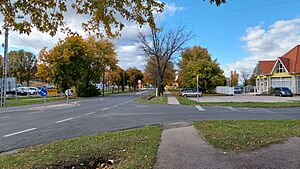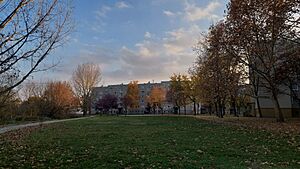Dorog facts for kids
Quick facts for kids
Dorog
|
|||
|---|---|---|---|
|
Town
|
|||
 |
|||
|
|||
| Lua error in Module:Location_map at line 416: Malformed coordinates value. | |||
| Country | |||
| County | Komárom-Esztergom | ||
| District | Esztergom | ||
| Area | |||
| • Total | 11.54 km2 (4.46 sq mi) | ||
| Population | |||
| • Total | 11,996 | ||
| • Density | 1,039.5/km2 (2,692.3/sq mi) | ||
| Time zone | UTC+1 (CET) | ||
| • Summer (DST) | UTC+2 (CEST) | ||
| Postal code |
2510
|
||
| Area code | (+36) 33 | ||
| Website | https://www.dorog.hu/ | ||
Dorog is a small town in Komárom-Esztergom County, Hungary. It's about 38 kilometers (24 miles) northwest of Budapest, Hungary's capital city. The town's name in German is Drostdorf.
Contents
What's in a Name?
The name Dorog comes from an old Slavic word, drugъ. This word means "partner," "comrade," or "brother."
A Look at Dorog's History
The valley where Dorog is located has been home to people since the Neolithic Age, which was a very long time ago.
The Romans built a military road that passed through this area. They even had homes here with floor heating! You can still find signs of their presence, like old pipes, graves, and milestones.
When Hungary's kings lived in Esztergom in the 11th and 12th centuries, Dorog was where the castle cooks stayed. Roads from all over met here, and the local church group could collect taxes from people passing through. The name "Dorog" was first written down in 1181.
The original town was destroyed during an invasion by the Ottomans. It was empty from 1542 until 1649. After that, German settlers, called Danube Swabians, came to live here, followed by Hungarians.
In the 18th century, Dorog became an important place for travel again. Famous people like Ferenc Kazinczy and István Széchenyi often visited the local inn. New houses and streets were built around the beautiful baroque Roman Catholic church, which was finished in 1775.
Mining and Growth
Coal mining started in Dorog in 1845. Many smart engineers helped develop the mines, finding more and more coal. By the early 1900s, Dorog was a major mining center. It was connected to Budapest by rail and to the Danube River by a canal.
In 1906, Dorog's power plant was built. It was later rebuilt in the 1980s with a very tall chimney. Around 1900, Dorog had nearly 2,000 people living there, including many Germans and Hungarians.
Between World War I and World War II, Budapest needed a lot of coal. This helped Dorog grow quickly. Many homes were built for the miners who moved to the town. A large worker's hostel, new churches, schools, a hospital, and a town hall were also constructed. Most of these buildings were designed by an engineer named Zoltán Gáthy.
Modern Dorog
About 300 men from Dorog lost their lives in World War II. After the war, many German residents had to leave. During the socialist era, Dorog changed into a typical socialist town with many apartment buildings.
As the mines slowly closed, the government brought in new factories. These included a medicine company (Gedeon Richter), a record plant (Hungaroton), and a machine factory. Dorog officially became a town in 1984, and an industrial park was set up in 1999.
Economy: What Dorog Makes
Dorog is home to several factories:
- Panasonic Corp. (used to make solar cells, but this factory is now closed)
- Gedeon Richter Plc. (makes medicine)
- Novoprint Corp. (a printing company)
- Dorog-Esztergom Hőerőmű Ltd. (the power plant)
Population: Who Lives in Dorog?
| Historical population | ||
|---|---|---|
| Year | Pop. | ±% |
| 1850 | 540 | — |
| 1857 | 837 | +55.0% |
| 1870 | 1,161 | +38.7% |
| 1880 | 1,163 | +0.2% |
| 1890 | 1,363 | +17.2% |
| 1900 | 1,966 | +44.2% |
| 1910 | 1,949 | −0.9% |
| 1920 | 3,943 | +102.3% |
| 1930 | 5,863 | +48.7% |
| 1941 | 8,182 | +39.6% |
| 1949 | 8,855 | +8.2% |
| 1960 | 9,994 | +12.9% |
| 1970 | 10,744 | +7.5% |
| 1980 | 11,844 | +10.2% |
| 1990 | 12,798 | +8.1% |
| 2001 | 12,609 | −1.5% |
| 2011 | 12,199 | −3.3% |
According to the 2001 census, most people in Dorog are Hungarians (95.3%). There is also a group of Germans (4.2%) and a small percentage of other groups.
Most people in Dorog are Roman Catholic (57.4%). Other religions include Calvinist (8.9%) and Lutheran (0.8%). Some people are Atheist (19.1%), and for others, their religion is unknown.
Getting Around Dorog
Several important roads, like Road 10, 111, and 117, pass through Dorog. The Budapest–Esztergom suburban railway line also crosses the town. Modern Siemens Desiro trains run on this line.
The main street in Dorog was rebuilt in 2006. There's also a Commuter bus (number 800) that connects Dorog to a metro station in Budapest. This bus runs often, usually every 20 or 30 minutes on weekdays.
Famous People from Dorog
- Jenő Buzánszky, footballer
- Gyula Grosics (1926-2014), footballer
- Imre Kozma (1940-), Roman Catholic priest, who helped East German refugees in Hungary
- Nándor Hargitai (1919-2006), footballer
- Péter Bacsa (1970-), wrestler
- Márta Megyeri (1952-), handball player
- Lajos Szűcs (1943-), footballer
- József Szabó (1956-), footballer
Sister Cities
Dorog has "sister city" relationships with several towns around the world. This means they share cultural ties and friendly connections.
See also
 In Spanish: Dorog para niños
In Spanish: Dorog para niños





